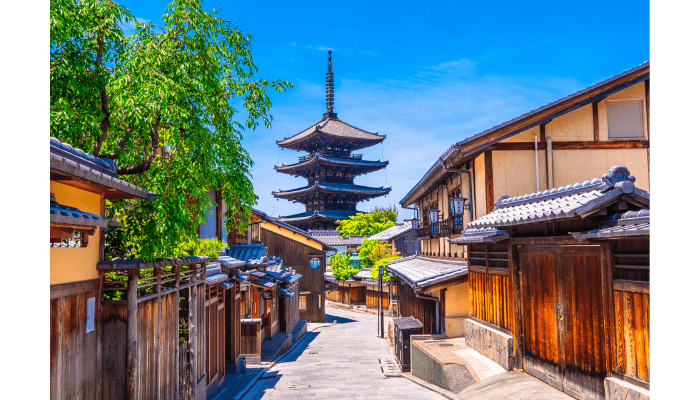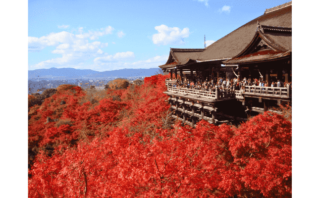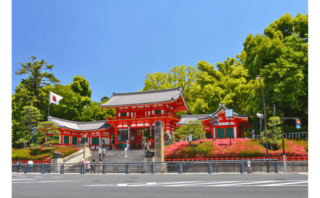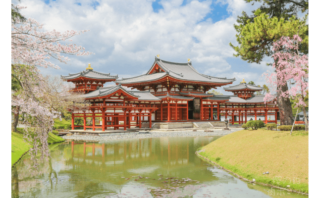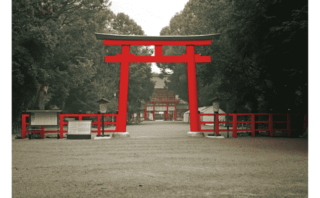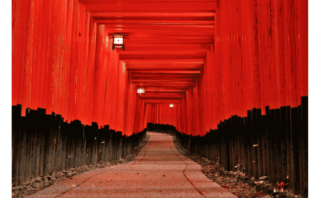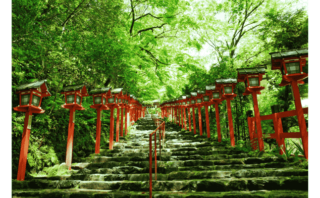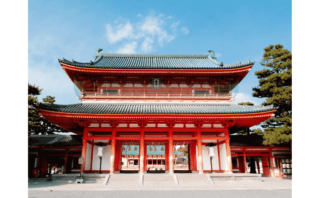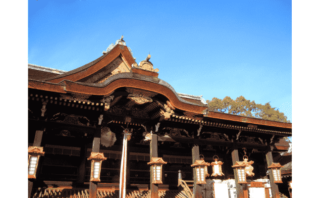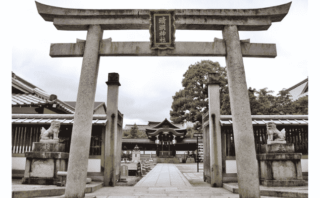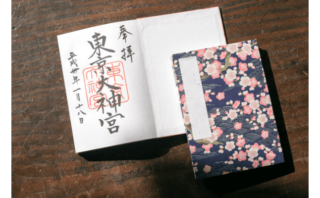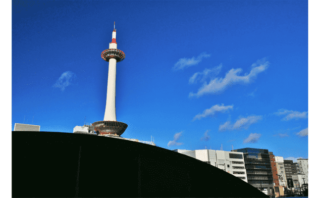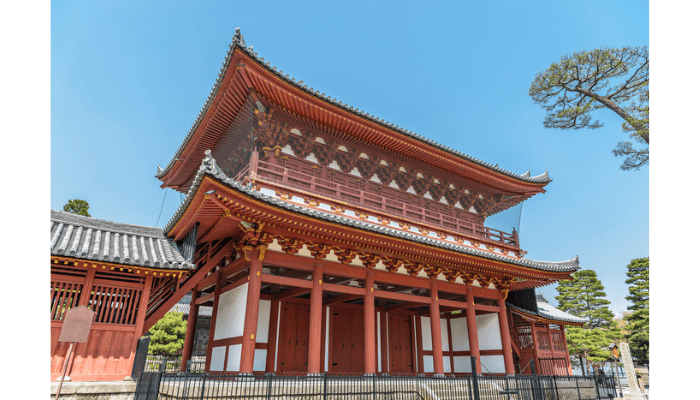Kyoto, the ancient capital of Japan, is a must-visit destination for both locals and international travelers. When visiting Kyoto, exploring its many shrines and temples is often an essential part of the itinerary.
You may find yourself returning to the same places, but learning about their history and the blessings they offer beforehand can make your visit even more meaningful. You might also enjoy discovering new shrines and temples, uncovering different sides of Kyoto along the way.
In this article, we’ll introduce some of the best shrines and temples in Kyoto, categorized by purpose—from love blessings to unique goshuin (temple stamps) and more!
Must-Visit Temples and Shrines for the Classics
Kyoto is home to countless shrines and temples, making it difficult to decide which ones to visit, even with the help of guidebooks and social media.
To help you out, we’ve put together a list of the most iconic temples and shrines that you should definitely include in your Kyoto itinerary. Kyoto has an excellent public transportation system, including trains, buses, and subways, so you can easily explore a wide area efficiently.
1. Kiyomizu-dera

Kiyomizu-dera is one of Kyoto’s most popular temples, famous for its wooden stage that juts out from the main hall. It’s a must-visit spot for student trips and international tourists alike.
The temple was founded in 778, over 1,200 years ago, making it one of the few temples in Kyoto that predates the city’s establishment as Japan’s capital in the Heian period. According to legend, a monk named Kenshin had a vision of an old man in white robes who told him to search for a sacred spring to the north. This vision led to the founding of Kiyomizu-dera.

The temple’s iconic wooden stage offers a stunning panoramic view of Kyoto, a sight that has captivated visitors for centuries. In 1994, Kiyomizu-dera was designated as a UNESCO World Heritage Site as part of the “Historic Monuments of Ancient Kyoto.”
On the way to the temple, you’ll walk along Kiyomizu-zaka Street, lined with souvenir shops and cafés—perfect for a leisurely stroll before or after your visit.
Kiyomizu-dera
- Address: 1-294 Kiyomizu, Higashiyama-ku, Kyoto
- Google Maps: Click here
- Access: Take Kyoto City Bus Route 206 or Route 100 to Gojo-zaka Bus Stop, then walk 10 minutes
- Phone: 075-551-1234
- Hours: 6:00 AM – 6:00 PM (July & August until 6:30 PM)
- Special Night Viewing (Spring, Summer, Autumn): Last entry at 9:00 PM
- Admission:
- 400 yen (high school & above)
- 200 yen (elementary & middle school)
- same price for night viewing
- Official Website: Kiyomizu-dera
2. Yasaka Shrine
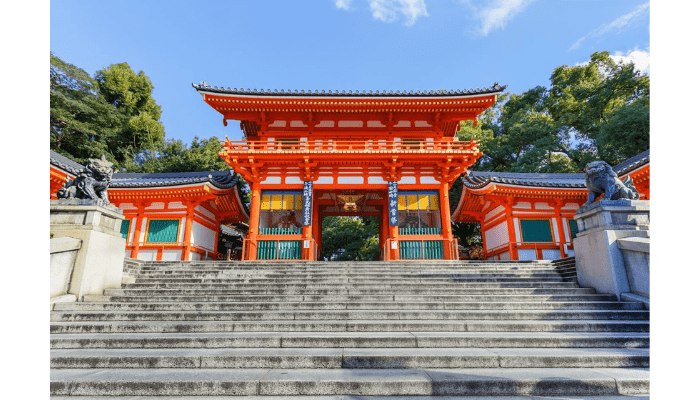
At the eastern end of Shijo Street, one of Kyoto’s main roads, stands the striking vermilion-red West Sakura Gate of Yasaka Shrine. This shrine is the head shrine of all Yasaka Shrines across Japan.
Before being renamed Yasaka Shrine in 1868, it was known as Kanjin-in or Gion-sha. Locals affectionately call it “Gion-san” or “Yasaka-san”.

Many legends surround Yasaka Shrine. One well-known story among locals is that a large underground pond lies beneath the main hall, with water veins extending to Shinsen-en (west of Kyoto) and To-ji Temple (south of Kyoto).
It is also said that the pond is a “dragon’s lair” where a blue dragon has dwelled for centuries, protecting the city of Kyoto.

Yasaka Shrine is the home of the Gion Festival (Gion Matsuri), one of Kyoto’s three major festivals, with a history spanning over 1,100 years. The festival begins on July 1st with the Kippu-iri ritual and lasts the entire month, ending on July 31st with the Eki Shrine Nagoshi-sai purification ceremony.
If you’re visiting Kyoto in July, be sure to experience the vibrant atmosphere of the Gion Festival at night and stop by Yasaka Shrine.
Yasaka Shrine
- Address: 625 Gion-machi Kitagawa, Higashiyama-ku, Kyoto
- Google Maps: Click here
- Access: 5-minute walk from Keihan Gion-Shijo Station
- Phone: 075-561-6155
- Hours: Shrine Office: 9:00 AM – 5:00 PM (Open 24 hours for worship)
- Official Website: Yasaka Shrine
3. Byodoin Temple

Located in Uji, Kyoto, Byodoin Temple is a historic site closely associated with the Fujiwara clan. While it is a short trip from central Kyoto, it is one of Japan’s most recognizable temples, as it appears on the 10-yen coin.
The Phoenix Hall (Hoo-do), built over a pond, is the temple’s most famous structure. Its striking vermilion reflection on the water creates an atmosphere of serenity and grandeur. In 1994, Byodoin was designated a UNESCO World Heritage Site, attracting visitors from around the world.

Byodoin was founded in 1052 by Fujiwara no Yorimichi. At the time, many believed in Mappo, the idea that after 2,000 years following Buddha’s passing, the world would fall into chaos and Buddhism would decline. Hoping to be reborn in the Pure Land paradise, Yorimichi built Byodoin as a place of worship and prayer for salvation in the afterlife.

Byodoin is also known for its seasonal beauty. In spring, visitors can admire weeping cherry blossoms, Somei Yoshino cherry trees, and 10,000 wisteria flowers in full bloom. In autumn, the vibrant red and orange maple leaves create a breathtaking scene alongside the Phoenix Hall. Each visit offers a unique and memorable experience.
Byodoin Temple
- Address: 116 Uji Renge, Uji City, Kyoto
- Google Maps: Click here
- Access:
- 10-minute walk from JR Uji Station (Nara Line)
- 10-minute walk from Keihan Uji Station
- Phone: 0774-21-2861
- Opening Hours:
- Temple Gardens: 8:30 AM – 5:30 PM (Last entry: 5:15 PM)
- Phoenix Hall Interior: 9:30 AM – 4:10 PM (Limited to 50 visitors per session, first come first served)
- Byodoin Museum Hoshokan: 9:00 AM – 5:00 PM (Last entry: 4:45 PM)
- Museum Shop: 9:00 AM – 5:00 PM
- Goshuin Stamp Office: 9:00 AM – 5:00 PM
- Admission Fees:
- Temple Gardens & Byodoin Museum:
- Adults: ¥600
- Junior & High School Students: ¥400
- Elementary School Students: ¥300 (Free for preschoolers)
- Phoenix Hall Interior: ¥300 (Limited to 50 visitors per session, every 20 minutes)
- Official Website: Byodoin Temple
4. Shimogamo Shrine

Located in Sakyo Ward, Kyoto, Shimogamo Shrine is a UNESCO World Heritage Site officially known as Kamo Mioya Shrine. It is called Shimogamo because it is situated downstream of the Kamo River.
With a history dating back to mythological times, Shimogamo Shrine is one of Kyoto’s oldest shrines. Records show that its sacred fence was rebuilt in 90 BCE, suggesting that the site had been a place of worship long before that.
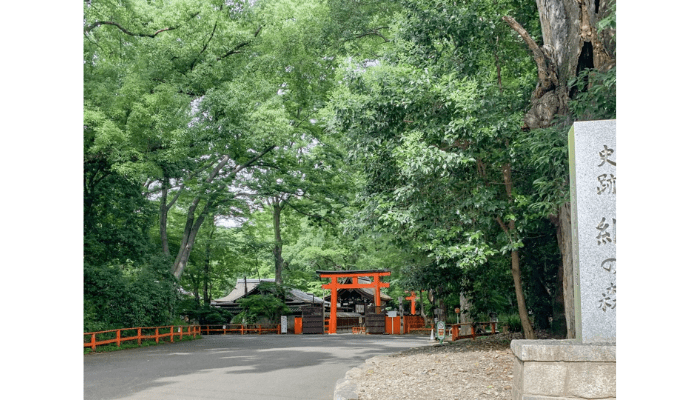
Leading up to the shrine is Tadasu no Mori, a lush and sacred forest covering 124,000 square meters—about three times the size of Tokyo Dome. A small stream runs alongside the path, creating a tranquil atmosphere that makes visitors feel as if they have stepped away from the noise of daily life.

One of the shrine’s highlights is Mitarashi Pond, home to a special water fortune slip (mizu-mikuji). Instead of reading your fortune immediately, you must place the slip in the pond, where the writing gradually appears, adding an element of excitement.

The famous mitarashi dango (sweet soy-glazed rice dumplings) were inspired by the bubbles that naturally form in Mitarashi Pond. Near the west side of Shimogamo Shrine, you’ll find Kamo Mitarashi Chaya, a teahouse believed to be the birthplace of mitarashi dango.
If you visit Shimogamo Shrine, be sure to stop by and try this delicious local treat!
Shimogamo Shrine
- Address: 59 Shimogamo Izumigawa-cho, Sakyo-ku, Kyoto
- Google Maps: Click here
- Access:
- 3-minute walk from the Shimogamo Jinja-mae bus stop
- 12-minute walk from Demachiyanagi Station (Keihan Line)
- Phone: 075-781-0010
- Opening Hours: 6:30 AM – 5:00 PM
- Admission: Free
- Official Website: Shimogamo Shrine
5. Fushimi Inari Taisha

Fushimi Inari Taisha is the head shrine of all Inari shrines in Japan, which are commonly known as Oinari-san. There are around 30,000 Inari shrines across the country, but this one in Kyoto is the most important.
It has also been a favorite among international travelers, ranking No.1 on a popular travel review site’s list of “Top Tourist Attractions in Japan for Foreign Visitors” for five consecutive years.

The highlight of Fushimi Inari Taisha is undoubtedly the famous Senbon Torii, or “Thousand Torii Gates.” These striking vermilion gates create a breathtaking tunnel along the shrine’s pathways.
This tradition began in the Edo period (1603–1868) when worshippers started donating torii gates as a way to express their gratitude and prayers. Today, the sight of countless torii gates stretching into the distance is a must-see for photographers and travelers. It’s also common to spot visitors dressed in yukata (summer kimono), adding to the picturesque scenery.
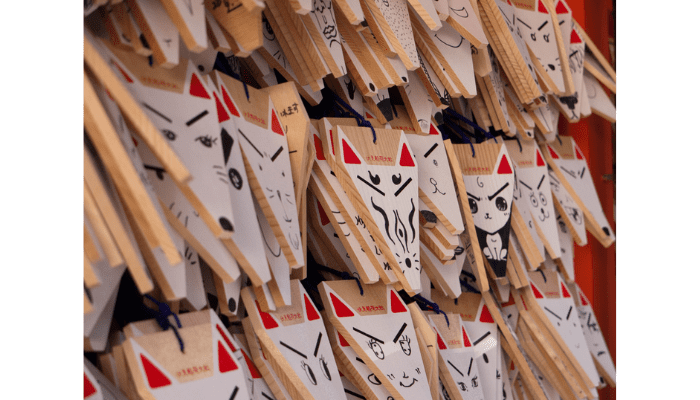
At many Japanese shrines, visitors write their wishes on wooden plaques called ema, but at Fushimi Inari Taisha, these ema are shaped like fox faces. You can draw your own unique fox expression along with your wish, making for a fun and memorable experience.
Fushimi Inari Taisha
- Address: 68 Fukakusa Yabunouchi-cho, Fushimi-ku, Kyoto
- Google Maps: Click here
- Access:
- Right in front of Inari Station (JR Nara Line)
- 5-minute walk from Fushimi Inari Station (Keihan Main Line)
- Phone: 075-641-7331
- Opening Hours:
- Open 24 hours (free access)
- Prayer services: 8:30 AM – 4:30 PM (last reception around 4:00 PM)
- Amulets & charms: 8:00 AM – 5:30 PM
- Admission: Free
- Official Website: Fushimi Inari Taisha
Must-Visit Temples and Shrines for Love & Romance
When walking through Kyoto, you’ll often see couples dressed in yukata (traditional summer kimono). Along the Kamo River, especially between Sanjo Bridge and Shijo Bridge, many couples sit and chat, enjoying the romantic atmosphere.
Kyoto is a popular destination for couples, and it’s home to many shrines and temples dedicated to love and relationships. From romantic fortune-telling to matching yukata outfits, here are some of the best spiritual spots for lovebirds!
1. Kifune Shrine
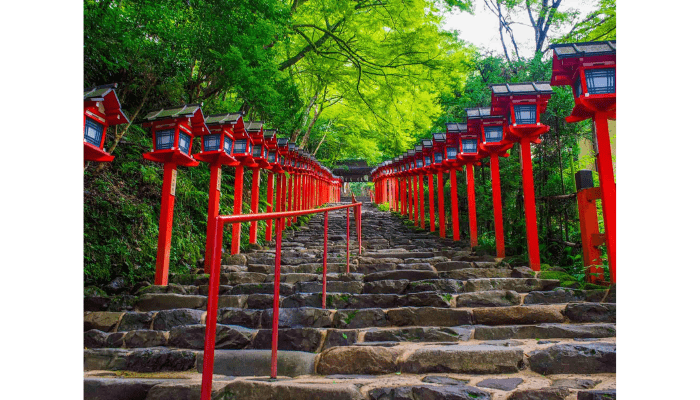
Nestled in the lush greenery of Kyoto’s northern mountains, Kifune Shrine is a historic shrine famous for its strong connection to love and relationships. It’s a popular spot among women, and because it’s surrounded by nature, it stays cooler than the city center—perfect for a refreshing summer visit.
One of its most iconic sights is the pathway lined with vibrant red lanterns, creating a picture-perfect setting for Instagram-worthy photos!

At the main shrine (Honmiya), you can try the special water fortune-telling (Mizuura-mikuji). Simply place the paper in the shrine’s sacred spring water, and your fortune will magically appear! This unique experience is perfect for couples looking to test their love luck.
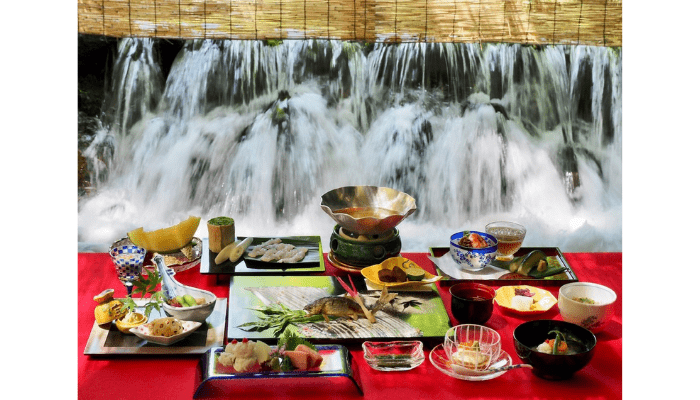
After visiting the shrine, why not enjoy a meal by the river? The Kawadoko (riverside dining) experience along Kifune River is a famous Kyoto summer tradition. Enjoy delicious Kyoto cuisine while listening to the sound of gently flowing water, creating a truly romantic and luxurious atmosphere.
Kifune Shrine
- Address: 180 Kurama-Kibune-cho, Sakyo-ku, Kyoto
- Google Maps: Click here
- Access:
- Approx. 20 minutes by bus from Kyoto International Conference Center Station
- About 30 minutes on foot from Kibuneguchi Station (Eizan Railway Kurama Line)
- Take Kyoto Bus No. 33 from Kibuneguchi Station and get off at Kibune Station (short walk from there)
- Phone: 075-741-2016
- Opening Hours:
- Main Shrine (Honmiya):
- 6:00 AM – 8:00 PM (May–Nov)
- 6:00 AM – 6:00 PM (Dec–Apr)
- Reception for amulets, goshuin, and water fortunes: 9:00 AM – 5:00 PM
- During the Kifune Momiji Lantern Festival: Open until 8:30 PM
- Main Shrine (Honmiya):
- Admission: Free (Goshuin stamp: 300 yen)
- Official Website: Kifune Shrine
2. Heian Shrine
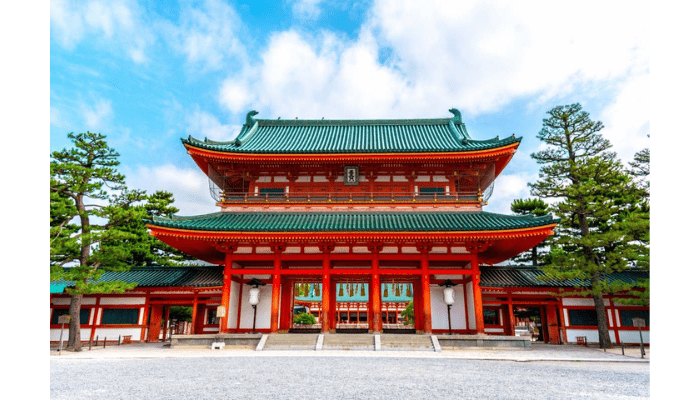
Heian Shrine was built in 1895 to commemorate the 1,100th anniversary of Kyoto’s founding and enshrine Emperor Kanmu, the ruler who established Kyoto as Japan’s capital in 794. At the time, Kyoto had declined due to the capital’s relocation to Tokyo and the turmoil of the late Edo period. However, people from Kyoto and across Japan came together with a shared desire to restore Kyoto’s former glory, leading to the creation of Heian Shrine as a symbol of the city’s revival.
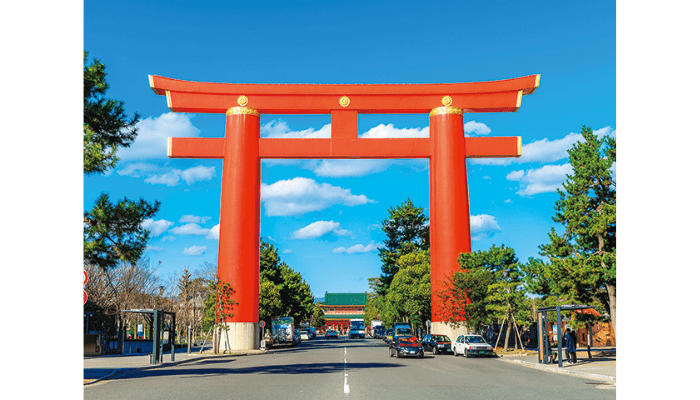
Your visit begins by passing through the massive Otenmon Gate, a reconstruction of the Chodoin (the main government hall of ancient Kyoto) at five-eighths of its original size. Standing before it, you can’t help but be overwhelmed by its grand presence.
Turning around from the gate, you’ll see a huge torii gate standing 300 meters away—one of the largest vermillion torii gates in Japan. This marks the entrance to Heian Shrine and is a striking landmark in Kyoto’s Okazaki area.

Inside the vast shrine grounds, you’ll find majestic shrine buildings designed after the imperial court architecture of the Heian period. Surrounding them is a beautifully maintained Japanese garden, making this an excellent place for a peaceful stroll.
Heian Shrine is especially famous for its spring cherry blossoms, with over 20 varieties of sakura, including the breathtaking yae-shidare-zakura (double weeping cherry blossoms). During peak bloom, the shrine attracts many visitors who come to admire the pink blossoms against the shrine’s bright vermillion structures.
With its impressive scale, historical significance, and seasonal beauty, Heian Shrine is a must-visit destination in Kyoto!
Heian Shrine
- Address: 97 Okazaki Nishitenno-cho, Sakyo-ku, Kyoto
- Google Maps: Click here
- Access:
- 5-minute walk from the Okazaki Park / Museum of Art / Heian Shrine bus stop (Kyoto City Bus No. 5, Raku Bus 100 & 110)
- 10-minute walk from Higashiyama Station (Kyoto Subway Tozai Line)
- Phone: 075-761-0221
- Opening Hours:
- Shrine Grounds: 6:00 AM – 6:00 PM
- (Nov – Feb 14: until 5:00 PM / Feb 15 – Mar 14 & Oct: until 5:30 PM)
- Garden (Shinen Garden): 8:30 AM – 5:30 PM
- (Mar 15 – Sep 30: until 6:00 PM / Nov 1 – Feb: until 5:00 PM)
- Shrine Grounds: 6:00 AM – 6:00 PM
- Admission: Free (Shinen Garden: 600 yen for adults / 300 yen for children)
- Official Website: Heian Shrine
3. Yasui Konpiragu Shrine

Located in Higashiyama, Kyoto, Yasui Konpiragu Shrine is famous as a “relationship-cutting shrine”. Many visitors come here to sever bad relationships—whether with people, bad habits, or negative influences. However, this shrine isn’t just about cutting ties; it’s also known for bringing good relationships, making it a popular power spot in Kyoto.
The approach to the shrine is often called “Ema no Michi” (Path of Ema) because of the countless wooden plaques left by visitors praying for a fresh start. While the sight may seem intense, the shrine also attracts those seeking good fortune in love and relationships. Some plaques were even dedicated by famous people, making it interesting to take a closer look.

The highlight of Yasui Konpiragu is the “Enkiri-Enmusubi Ishi” (Relationship-Cutting and Relationship-Binding Stone), believed to help people break bad ties and form positive ones.
Here’s how the ritual works:
- Write your wish on a katashiro, a small piece of paper provided at the shrine.
- Holding the katashiro, crawl through the hole in the stone from the front. This symbolizes cutting off negative connections.
- Then, crawl back through the hole from the opposite side to invite good relationships into your life.
- Finally, paste your katashiro onto the stone with glue as a sign of your completed wish.
The hole in the stone is just big enough for an adult to squeeze through, making the ritual a memorable and symbolic experience.
With its unusual yet powerful prayer method, Yasui Konpiragu Shrine is a fascinating place to reset your relationships and start fresh.
Yasui Konpiragu Shrine
- Address: 70 Shimobenten-cho, Higashiyama-ku, Kyoto
- Google Maps: Click here
- Access:
- 1-minute walk from the Higashiyama Yasui bus stop
- 10-minute walk from Gion-Shijo Station (Keihan Railway)
- Phone: 075-561-5127
- Opening Hours: Open 24 hours (Blessing reception: 9:00 AM – 5:30 PM)
- Admission: Free
- Official Website: Yasui Konpiragu Shrine
4. Suzumushi Temple

Suzumushi Temple, officially called Kegon-ji, is a unique temple in Kyoto where you can hear the chirping of crickets (suzumushi) all year round. This rare sight has earned the temple its popular nickname, “Suzumushi-dera” (Cricket Temple). It’s not common to see crickets being raised in a temple, making this place truly special.
As you climb the stone steps at the entrance, you’ll be greeted by a special Jizo statue. It is believed that this Jizo grants any wish—but only one per person. So, before you visit, be sure to think carefully about your most important wish!
The most famous experience at Suzumushi Temple is the sermon given by the head monk. Many people might imagine Buddhist sermons to be serious or difficult to understand, but here, it’s different! The monks deliver their teachings in a style similar to Japanese comedy, like Rakugo or stand-up, making the experience fun and engaging.

During the 30-minute talk, the monk shares stories about the temple, how to pray, and thoughts on daily life. The teachings are so captivating that you might even forget about the chirping crickets!
After the sermon, visitors can stroll through the temple’s beautiful garden, or go to the Jizo statue to make their wish. Even from the temple’s main hall, you can often hear the sound of visitors laughing—a rare and heartwarming atmosphere for a temple visit.
It’s not every day that you get to hear a Buddhist sermon while listening to the peaceful sound of crickets. If you’re looking for a unique and spiritual experience in Kyoto, Suzumushi Temple is a must-visit!
Suzumushi Temple (Kegon-ji)
- Address: 31 Matsumuro Jikecho, Nishikyo-ku, Kyoto
- Google Maps: Click here
- Access:
- 10-minute walk from Matsuo-Taisha Station (Hankyu Railway)
- Phone: 075-381-3830
- Opening Hours: 9:00 AM – 5:00 PM (Last entry: 4:30 PM)
- Admission:
- Adults: 500 yen
- Children (ages 4 to junior high school): 300 yen (includes tea and sweets)
- Official Website: Suzumushi Temple
5. Yasaka Koshindo
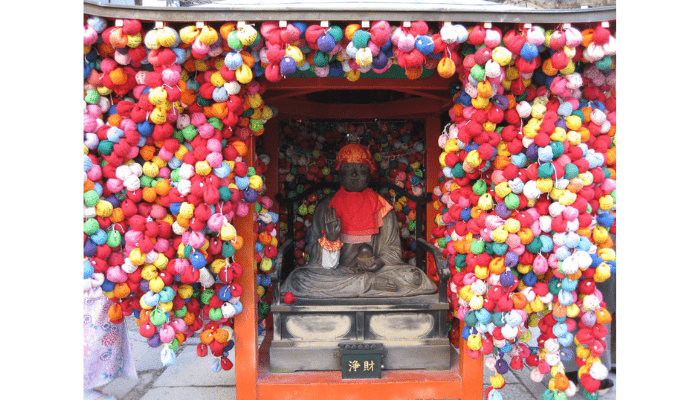
As you stroll along Yasaka Street, a lively area filled with cafés and souvenir shops, you’ll find Yasaka Koshindo, a small but charming temple on the way to Kiyomizu-dera. Locals affectionately call it “Yasaka no Koshin-san.”
Recently, this hidden gem has become a popular photo spot, especially among visitors wearing kimono and couples looking for a beautiful background for their pictures.
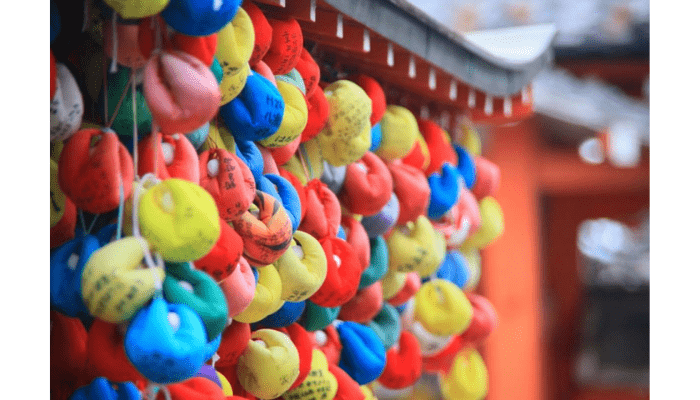
Peeking through the bright red temple gate, you’ll notice countless colorful, round fabric charms hanging inside. These are called “Kukurizaru,” Yasaka Koshindo’s famous wish charms.
To make a wish, visitors write their desire on a Kukurizaru and hang it at the temple. The charm represents a monkey with its hands and feet tied, symbolizing self-control—letting go of earthly desires to achieve happiness.
Since only 100 charms are available on weekdays and 300 on weekends, it’s best to visit early if you want to get one!
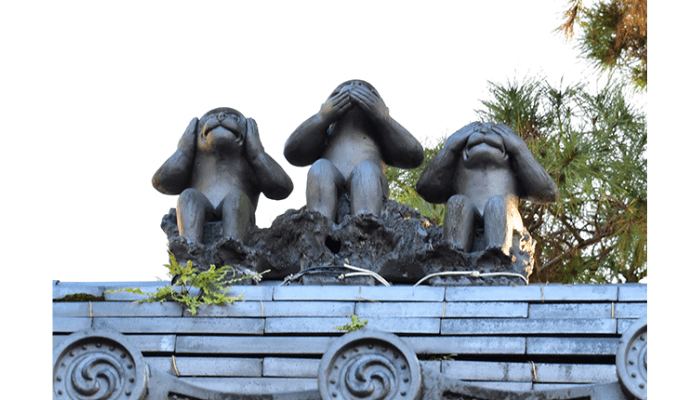
Inside the temple, you’ll also find statues of the famous “Three Wise Monkeys” from Nikko’s Toshogu Shrine—a symbol of wisdom and good conduct. The temple offers various monkey-themed charms that make great souvenirs, as they are both cute and meaningful.
If you’re looking for a unique Kyoto experience and a great photo spot, Yasaka Koshindo is a must-visit!
Yasaka Koshindo Temple
- Address: 390-1 Kanezono-cho, Higashiyama-ku, Kyoto
- Google Maps: Click here
- Access:
- 5-minute walk from “Kiyomizu-michi” bus stop
- Phone: 075-541-2565
- Opening Hours: 9:00 AM – 5:00 PM
- Admission: Free
Must-Visit Temples and Shrines for Power Spots
Kyoto is home to countless power spots, but some are said to boost your fortune in extraordinary ways. Whether you’re looking for beauty, success in the entertainment industry, or a fresh start, these sacred places offer a variety of blessings.
After a long period of staying at home in 2021, many people may have felt their energy levels drop. When you need motivation to start something new or simply want to pause and reflect, visiting a spiritual power spot can help reset your mind and body.
Why not explore Kyoto’s most powerful temples and shrines—places even locals visit frequently—to recharge your energy?
1. Sennyu-ji Temple
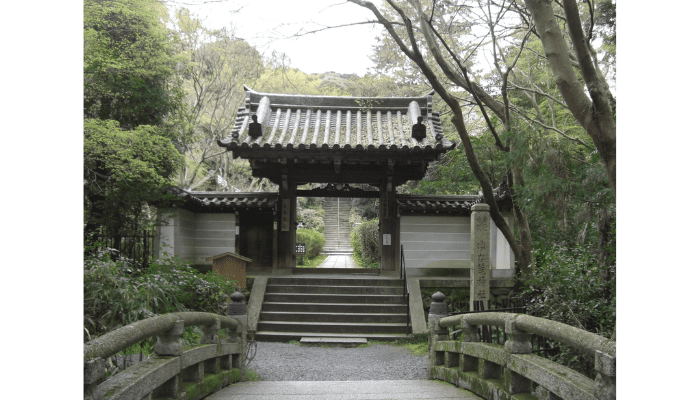
Located in Higashiyama, Kyoto, Sennyu-ji Temple was founded over 1,200 years ago. It has long been a temple of the imperial family, earning the title “Mitera” (The Imperial Temple).
Perhaps due to its deep historical significance, the temple grounds are filled with pure and sacred energy. Many visitors have reported experiencing a sense of calm, mental clarity, or even an unusual sensation while walking through the temple. This powerful spiritual presence is likely one of the reasons why Japan’s emperors have worshipped here for centuries.
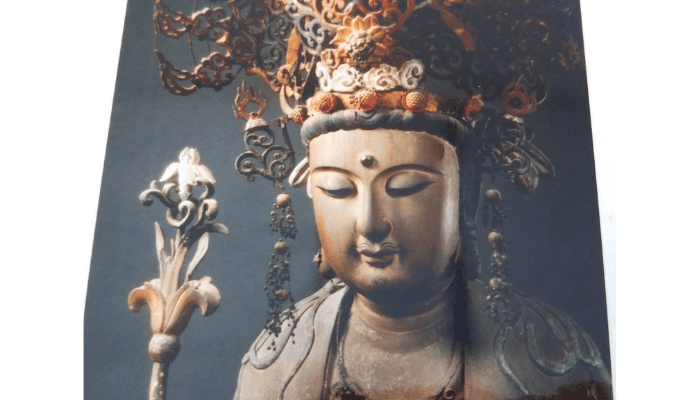
Among the temple’s many important cultural treasures, one stands out—the statue of Yang Guifei. Yang Guifei, known as one of the Three Most Beautiful Women in World History, is said to grant blessings for beauty and romance.
Many women visit this sacred statue to pray for beauty and a destined encounter with their ideal partner. If you’re hoping to enhance your natural charm and attract love, a visit to Sennyu-ji’s Yang Guifei Kannon might be just what you need!
Sennyu-ji Temple
- Address: 27 Sennyuji-Yamanouchi-cho, Higashiyama-ku, Kyoto
- Google Maps: Click here
- Access:
- 15-minute walk from the “Sennyuji-michi” bus stop
- 20-minute walk from JR Tofukuji Station
- Phone: 075-561-1551
- Opening Hours:
- March–November: 9:00 AM – 4:30 PM
- December–February: 9:00 AM – 4:00 PM
- Admission Fees:
- General Admission: Adults ¥500 / Children (Elementary & younger) ¥300
- Special Admission: Adults ¥300 / Children ¥300
2. Kitano Tenmangu Shrine
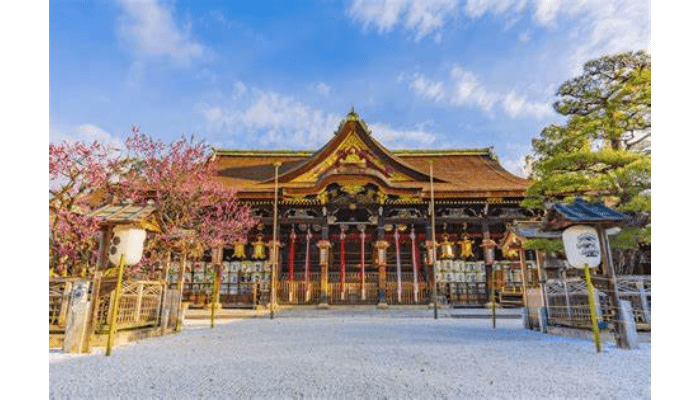
Kitano Tenmangu Shrine, affectionately known as “Kitano no Tenjin-sama”, is the head shrine of approximately 12,000 Tenmangu and Tenjin shrines across Japan. It enshrines Sugawara no Michizane, the god of learning and scholarship.

Sugawara no Michizane was a highly respected scholar and politician, but he was falsely accused and exiled to Kyushu, where he passed away. After his death, a series of natural disasters and misfortunes struck Kyoto, particularly affecting the powerful Fujiwara clan, which was involved in his exile. Many believed these events were caused by Michizane’s angry spirit, and to appease him, Kitano Tenmangu Shrine was built in the northwest of Heian-kyo (Kyoto’s old capital)—a direction considered sacred for protection.
Over time, the shrine became a guardian of the imperial palace, receiving devotion from emperors, samurai leaders, and shoguns throughout history.

Michizane was known for his exceptional intelligence from a young age. Because of this, he became revered as the god of learning, and today, Kitano Tenmangu is one of Japan’s most popular shrines for students and exam takers seeking academic success. Many visitors come from all over Japan to pray for good results in school and entrance exams.

At Kitano Tenmangu, oxen are considered divine messengers. Throughout the shrine grounds, you’ll find dozens of ox statues, known as “nade-ushi” (stroking oxen). It is said that if you touch the part of the ox that corresponds to your own body’s ailments, it will help heal you.
Kitano Tenmangu Shrine
- Address: Bakuro-cho, Kamigyo-ku, Kyoto
- Google Maps: Click here
- Access:
- From JR Kyoto Station, take City Bus No. 50 or 101 and get off at “Kitano Tenmangu-mae” (short walk to the shrine)
- 5-minute walk from Keifuku Electric Railway’s “Hakubai-cho Station”
- Phone: 075-461-0005
- Opening Hours:
- Main Gate: 6:30 AM – 5:00 PM
- (Open at night during special events, such as autumn illuminations and New Year’s)
- Office & Amulet Counter: 9:00 AM – 4:30 PM
- (Until 8:00 PM during the autumn illumination period)
- Prayer Services: 9:00 AM – 4:00 PM
- Main Gate: 6:30 AM – 5:00 PM
- Admission Fees:
- Treasure Hall: Adults ¥1,000 / High school & middle school students ¥500 / Children ¥250
- Plum Garden & Flower Garden: Adults ¥1,200 / Children ¥600 (includes tea & sweets)
- Autumn Maple Garden:
- Fresh Green Maple Season: Adults ¥500 / Children ¥350
- Autumn Leaves Season: Adults ¥1,000 / Children ¥600 (includes tea & sweets)
3. Seimei Shrine

Seimei Shrine, located in Kamigyo Ward, Kyoto, is dedicated to Abe no Seimei, a famous Onmyoji (master of yin-yang divination). The shrine was founded in 1007 by Emperor Ichijo to honor Seimei’s achievements after his death.
Abe no Seimei was a highly skilled Onmyoji, known for his deep knowledge of astronomy, divination, and spiritual protection. According to legend, he could command shikigami (spiritual beings) from a young age. Because of this, Seimei Shrine is believed to offer powerful protection against misfortune and evil spirits, making it a popular power spot in Kyoto.

One of the shrine’s most unique features is its golden pentagram crest, known as Seimei Kikyo (Seimei Bellflower). This five-pointed star (gobosei) is a sacred symbol in Onmyodo (the Way of Yin and Yang), a spiritual tradition developed by Abe no Seimei.
As you explore the shrine, you’ll notice pentagram symbols scattered throughout the grounds—finding them all adds to the fun of your visit!
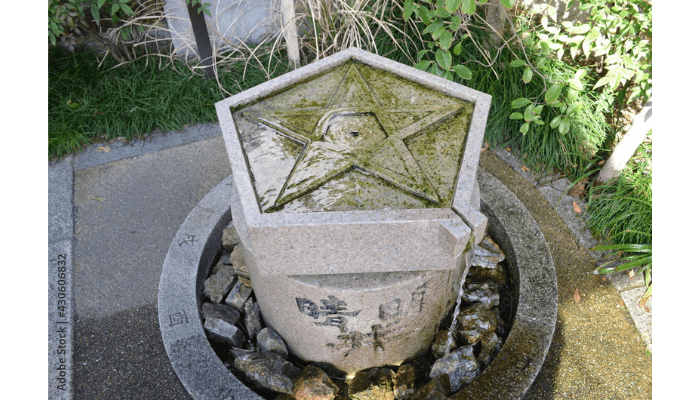
Just past the torii gate, you’ll find Seimei Well, one of the shrine’s most famous spots. According to legend, Abe no Seimei used his spiritual power to create this natural spring.
It is said that drinking the well’s water can bring good health and healing. If you’re concerned about safety, it’s recommended to boil the water before drinking.
Seimei Shrine
- Address: 806 Seimei-cho, Kamigyo-ku, Kyoto
- Google Maps: Click here
- Access:
- 2-minute walk from “Ichijo Modoribashi / Seimei Shrine-mae” Bus Stop
- 2-minute walk from “Horikawa Imadegawa” Bus Stop
- Phone: 075-441-6460
- Opening Hours:
- Shrine Grounds: 9:00 AM – 5:00 PM (Open every day)
- Amulet Counter: Until 4:30 PM
- Fortune-telling Consultation: 1:00 PM – 4:30 PM
- Admission: Free (Fortune-telling sessions start at ¥2,000 per reading)
4. Kurumazaki Shrine

Kurumazaki Shrine, located in Ukyo Ward, Kyoto, is famous for bringing good fortune in entertainment and the arts. Many actors, singers, and performers secretly visit this shrine to pray for success.
One of the shrine’s most eye-catching features is the countless red plaques, called “Shu no Tamagaki”, which are densely lined up throughout the shrine grounds. Each plaque bears the name of someone who has prayed for success in the entertainment industry.

You’ll find names of famous kabuki actors, dancers, singers, idols, and even manga characters! Searching for the name of your favorite celebrity can be an exciting experience.
Even if you’re not a celebrity, anyone working in entertainment, art, or creative fields can apply to have their name inscribed on a plaque. It will be displayed for two years, allowing you to stand alongside the stars!
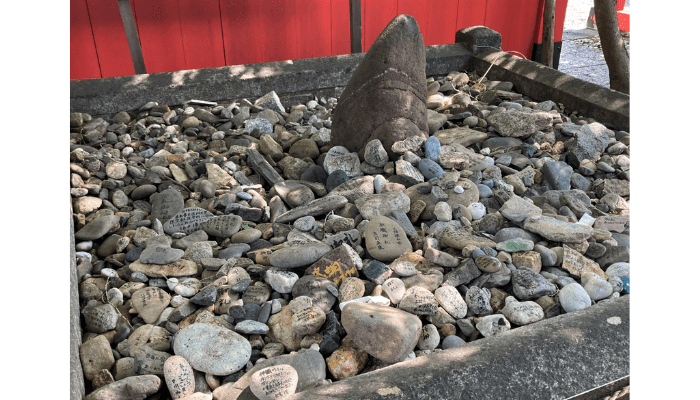
Kurumazaki Shrine is also known for its strong stone-related beliefs. One of the most famous items here is the “Kinen Shinseki” (Prayer Power Stone), which has been ritually blessed by the shrine’s priests. Visitors can take this stone home as a good luck charm to help fulfill their wishes.
Once your wish comes true, it’s considered good practice to pick up a natural stone from a river or mountain near your home, write a message of gratitude on it, and bring it back to the shrine. However, note that you do not return the Kinen Shinseki itself!
Kurumazaki Shrine
- Address: 23 Asahi-cho, Saga, Ukyo-ku, Kyoto
- Google Maps: Click here
- Access:
- 35-minute bus ride from JR Kyoto Station
- Short walk from Kurumazaki Shrine Station on the Keifuku Arashiyama Line
- Phone: 075-861-0039
- Opening Hours: 9:30 AM – 5:00 PM
- Kinen Shinseki (Prayer Power Stone):
- Charm type: ¥700
- Talisman type: ¥500
- Official Website: Kurumazaki Shrine
5. Matsuo Taisha
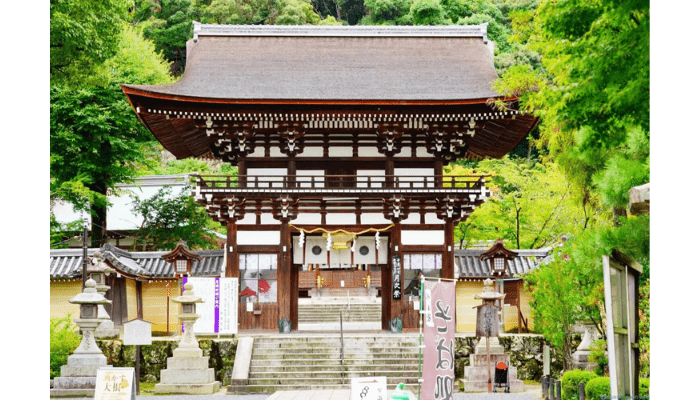
Matsuo Taisha is one of Kyoto’s oldest shrines, founded in 701 AD. During the Heian Period, it was worshiped as the guardian deity of Kyoto’s western side, protecting the capital from misfortune.
In ancient Kyoto, the city’s layout was designed according to Chinese geomancy (Feng Shui), with four guardian shrines representing the four celestial beasts:
- Genbu (North) – Kamigamo Shrine
- Suzaku (South) – Jonangu Shrine
- Seiryu (East) – Yasaka Shrine
- Byakko (West) – Matsuo Taisha
Many visitors follow the tradition of the “Five Shrine Pilgrimage”, which includes these four shrines plus Heian Shrine, dedicated to Emperor Kanmu, who founded Kyoto.
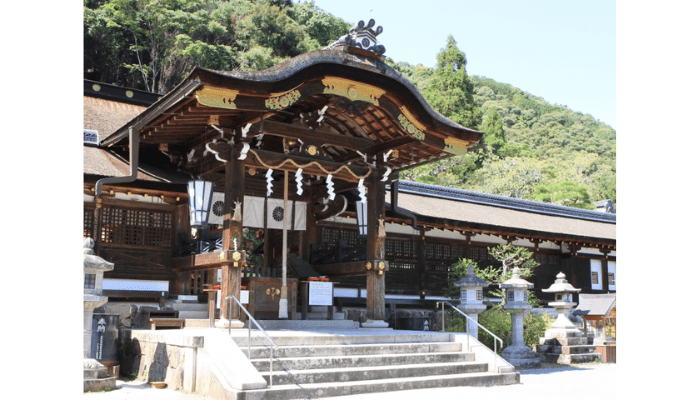
Matsuo Taisha is especially revered by people working in the sake brewing industry. The shrine enshrines Ōyamazumi-no-Kami, the god of brewing, making it a must-visit for sake makers seeking divine blessings.
As you explore the shrine, you’ll notice many turtle and koi (carp) statues. According to legend, when Ōyamazumi-no-Kami traveled up the Hozu River to establish the region, he rode on turtles in calm waters and on koi in strong currents.
Two special statues stand near the main hall:
- “Nadegame” (Lucky Touch Turtle) – Brings longevity and family harmony.
- “Sōkoi” (Lucky Twin Koi) – Grants success, love fulfillment, and a happy marriage.
Rubbing these statues is said to bring good fortune, so be sure to give them a gentle touch!
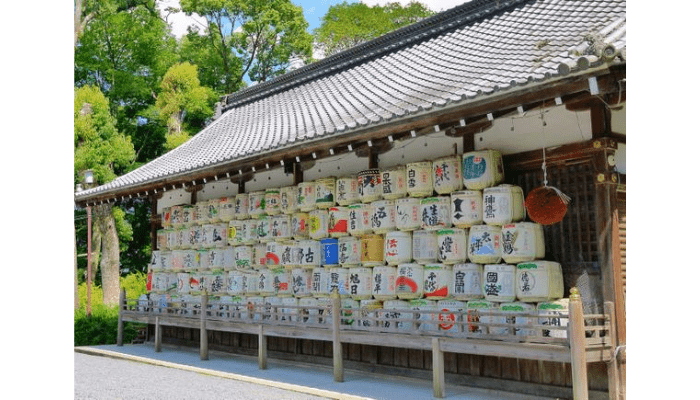
Beyond sake brewing, Matsuo Taisha is deeply connected to water and purification. It is also known for blessings in:
- Family safety
- Career success
- Construction & engineering
- Health & longevity
- Safe childbirth
- Love & matchmaking
Matsuo Taisha Shrine
- Address: 3 Miyamachi, Arashiyama, Nishikyo-ku, Kyoto
- Google Maps: Click here
- Access:
- 3-minute walk from Matsuo Taisha Station (Hankyu Arashiyama Line)
- Phone: 075-871-5016
- Opening Hours:
- Weekdays & Saturdays: 9:00 AM – 4:00 PM
- Sundays & Holidays: 9:00 AM – 4:30 PM
- Admission Fees (for the Garden & Sacred Statues Hall):
- Adults: ¥500
- Students: ¥400
- Children: ¥300
- Official Website: Matsuo Taisha
Must-Visit Temples and Shrines for Collecting Goshuin
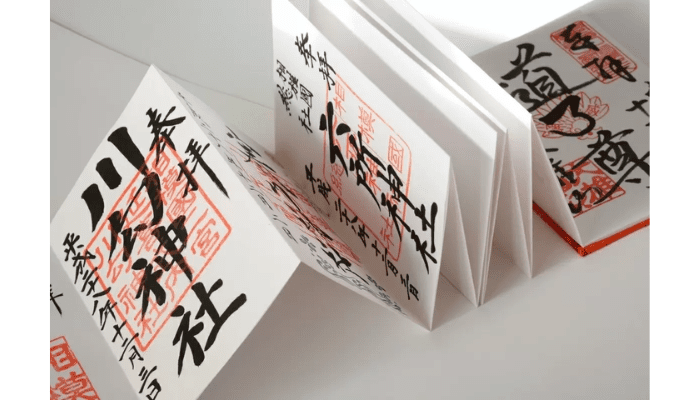
In recent years, collecting goshuin (official temple and shrine stamps) has become increasingly popular, especially among women. Each temple and shrine has its own unique designs and calligraphy, making goshuin collecting feel like an exciting stamp rally. By the time you fill an entire goshuincho (goshuin book), you might even feel your luck improving!
Kyoto, with its countless temples and shrines, is the perfect place to collect goshuin. Simply taking photos of famous landmarks is great, but why not make your trip even more special by collecting goshuin as souvenirs?
It’s also a fun activity to enjoy with friends or a partner, stopping by cafés or sightseeing spots along the way.
1. Daifuku-ji
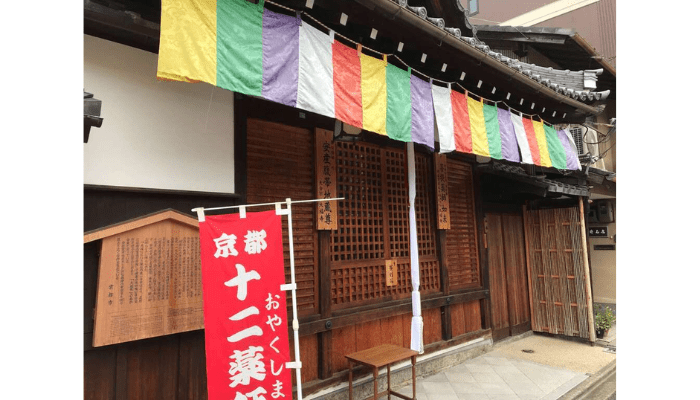
Daifuku-ji is a historic Tendai sect temple located in Nakagyo Ward, Kyoto. Despite its long history, it remains a hidden gem, making it a peaceful escape from Kyoto’s busy tourist spots.
The temple is situated near Kyoto Gyoen National Garden, right in the heart of the city.
Though Daifuku-ji once had larger grounds, two major fires destroyed most of the temple, leaving only its eight-tatami-mat-sized main hall. Unlike most temples, it has no gates or large grounds, and the small main hall stands alone in a residential area—so be careful not to walk past it!
Despite its small size, Daifuku-ji is a well-known power spot, attracting visitors of all ages.
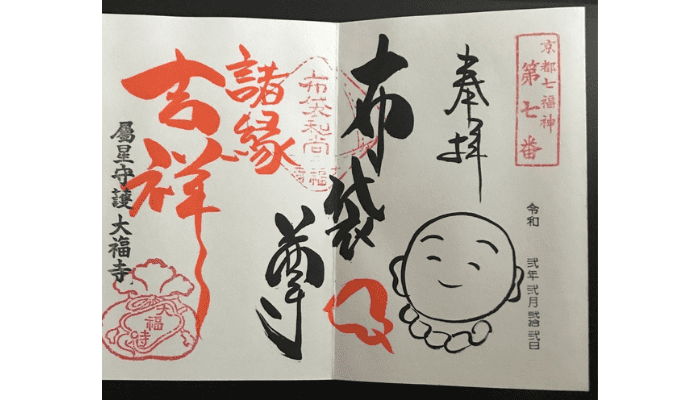
Daifuku-ji offers a range of goshuin, including:
✔ Shichifuku Goshuin (Seven Lucky Gods Goshuin)
✔ Daifuku-chō Goshuin (Prosperity Book Goshuin)
Seasonal limited-edition goshuin are also available, so you might receive a different design depending on when you visit!
The temple’s mini goshuin book is particularly popular among women. Its small and cute size makes it a great souvenir or a stylish way to start your goshuin collection.
Important Notice
Unlike many temples, Daifuku-ji does not offer goshuin every day. The official Twitter account announces the available dates, so be sure to check before visiting.
Daifuku-ji Temple
- Address: 498 Hoteiya-cho, Fuyacho-dori Nijyo Agaru, Nakagyo-ku, Kyoto
- Google Maps: Click here
- Access:
- 7-minute walk from Kyoto Shiyakusho-mae Station (Kyoto City Bus)
- 10-minute walk from Kyoto Shiyakusho-mae Station (Subway)
- Phone: 075-231-3624
- Opening Hours: 10:00 AM – 4:00 PM
- Admission: Free
- Important: Check the temple’s official Twitter for goshuin availability.
2. Bukko-ji Temple
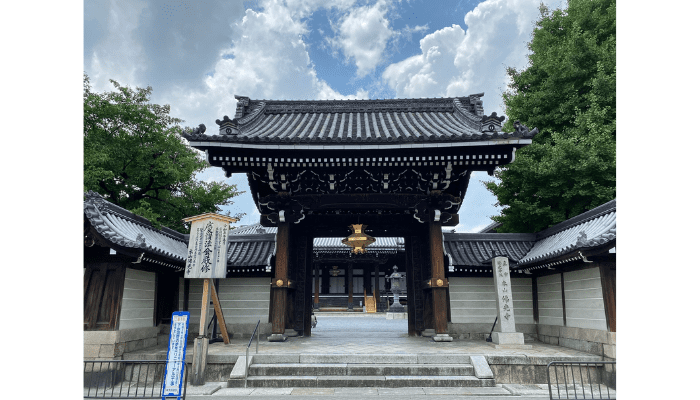
Bukko-ji Temple is a hidden gem located in the heart of Shijo-Karasuma, Kyoto’s bustling business district. Unlike the city’s famous temples, Bukko-ji is a quiet and peaceful spot, loved by locals for its calm atmosphere and fewer crowds.
On the 14th of every month, Bukko-ji hosts a vegetable market in its temple grounds. Here, you can find a variety of fresh, locally grown Kyoto vegetables, which change with the seasons.
For visitors, this is a great chance to see and even purchase some rare and unique Kyoto produce. If you’re interested in local food culture, try planning your visit around the market day!
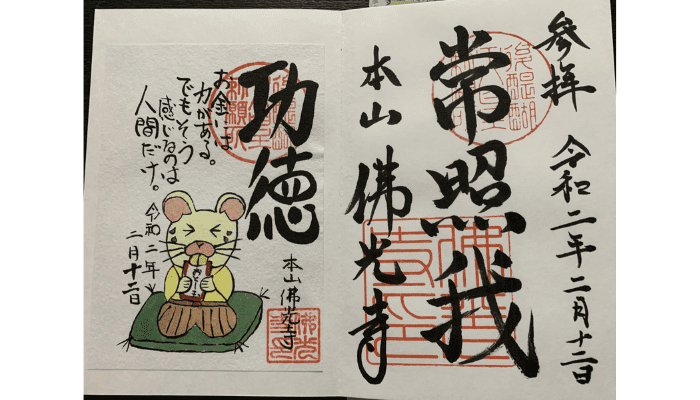
In the Jodo Shinshu (True Pure Land) sect of Buddhism, many temples do not offer goshuin (official temple stamps). However, Bukko-ji is an exception, making it a special place for goshuin collectors.
Bukko-ji’s goshuin design changes four times a year, based on the seasons:
Spring (March–May)
Summer (June–August)
Autumn (September–November)
Winter (December–February)
Collecting each seasonal goshuin is a unique way to mark the passage of time in Kyoto!
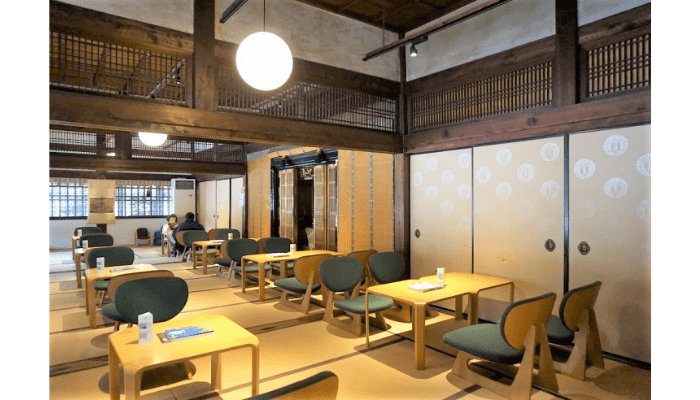
Unlike most temples, Bukko-ji has a café inside its grounds! “Café d Shokudo” is a small but stylish café, perfect for taking a break during your Kyoto explorations.
The café is run by D&DEPARTMENT KYOTO, a design shop also located within the temple grounds. From the café’s large windows, you can enjoy a beautiful view of Bukko-ji’s Amida Hall and Daishi Hall while sipping tea or enjoying a sweet treat.
Bukko-ji Temple
- Address: 397 Shinkai-cho, Shimogyo-ku, Kyoto
- Google Maps: Click here
- Access:
- 2-minute walk from Shijo Station (Subway)
- 5-minute walk from Karasuma Station (Hankyu Line)
- Phone: 075-341-3321
- Opening Hours: 9:00 AM – 4:00 PM
- Admission: Free
- Official Website: Bukko-ji Temple
3. Imamiya Shrine
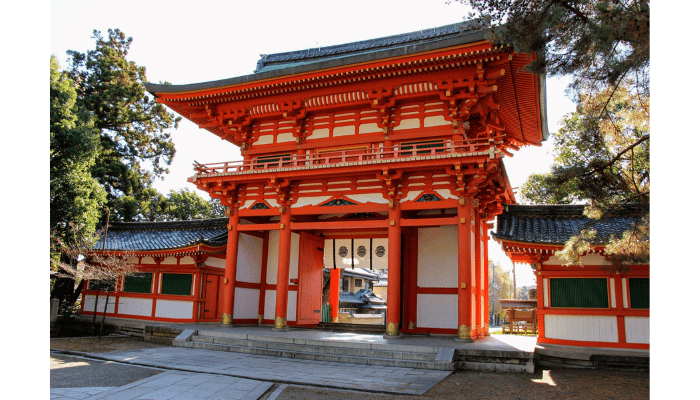
Located in Kyoto’s Kita Ward, Imamiya Shrine is often called the “Tama-no-Koshi Shrine” (meaning “rising to luxury through marriage”). This shrine is especially popular among women who wish for a prosperous and fortunate marriage.
The shrine’s reputation comes from the story of O-Tama, a young girl from Kyoto’s Nishijin district. In the Edo period, she worked as a servant in the women’s quarters of Edo Castle.
At the age of 13, she was noticed by Shogun Tokugawa Iemitsu, became his concubine, and later gave birth to Tokugawa Tsunayoshi—who would go on to become the fifth shogun of Japan.
Her influence in the Ōoku (the inner palace of the shogunate) grew, and she became one of the most powerful women of her time. Because of her incredible rise in status, the shrine became a symbol of good fortune and success in marriage.
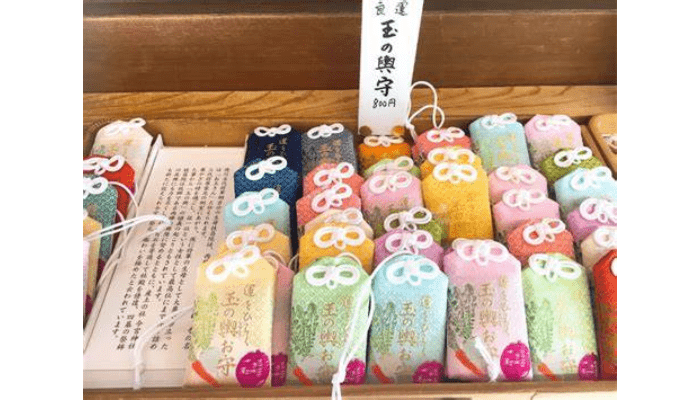
At Imamiya Shrine, you can even find a special “Tama-no-Koshi Omamori” (lucky charm) to help bring love and prosperity into your life!
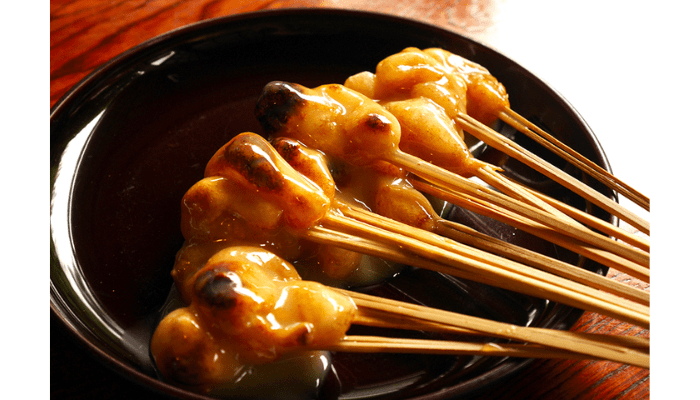
A visit to Imamiya Shrine isn’t complete without trying aburi mochi, a delicious Kyoto specialty.
What is Aburi Mochi?
- Small pieces of soft rice cake (mochi) are coated in roasted soybean flour (kinako).
- They are grilled over Binchotan charcoal, giving them a slightly smoky flavor.
- The final touch is a sweet white miso sauce, which adds a unique Kyoto-style taste.
This traditional sweet is said to bring good health and protection from illness.
Two historic teahouses selling aburi mochi stand face-to-face near the shrine’s east gate. The recipe and preparation method have remained unchanged since the Heian period (over 1,000 years ago)!
If you want to taste Kyoto’s history, this is a must-try treat!
Imamiya Shrine
- Address: 21 Murasakino Imamiya-cho, Kita-ku, Kyoto
- Google Maps: Click here
- Access:
- Right in front of the “Imamiya Shrine” bus stop
- Phone: 075-491-0082
- Opening Hours: 9:00 AM – 5:00 PM (Shrine Office)
- Admission: Free
- Official Website: Imamiya Shrine
4. Mikane Shrine
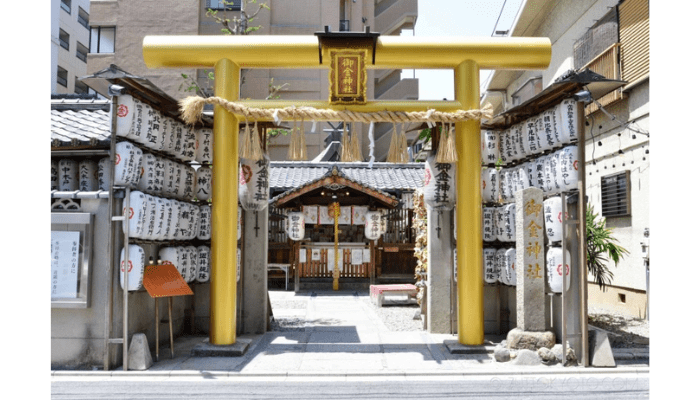
If you’re hoping to attract wealth and good fortune, a visit to Mikane Shrine is highly recommended!
Mikane Shrine (御金神社, pronounced “Mikane Jinja”) is known as a power spot for financial success. As its name suggests (“Mikane” means “gold” in Japanese), the shrine is believed to bring good luck with money. Locals and visitors from all over Japan come here to pray for financial prosperity.
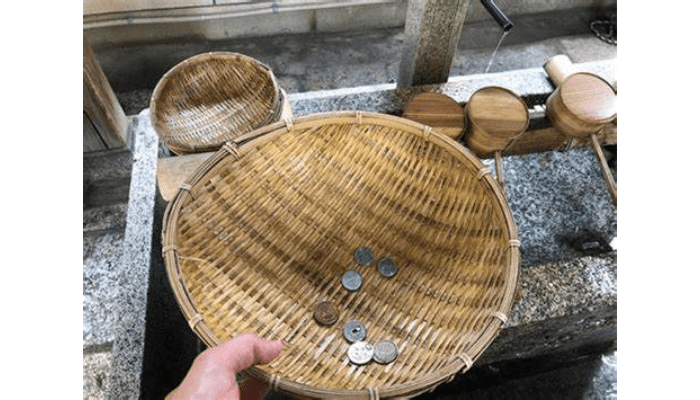
Located near Nijo Castle, the shrine stands out among the surrounding buildings with its shiny golden torii gate—a symbol of its reputation for wealth and success.
Mikane Shrine is the only shrine in Japan that enshrines Kanayamahiko-no-Kami, the deity of metal.
Because money is made of metal, people believe that worshipping here can boost financial luck, making it a popular destination for those wishing for business success, lottery winnings, or general prosperity.
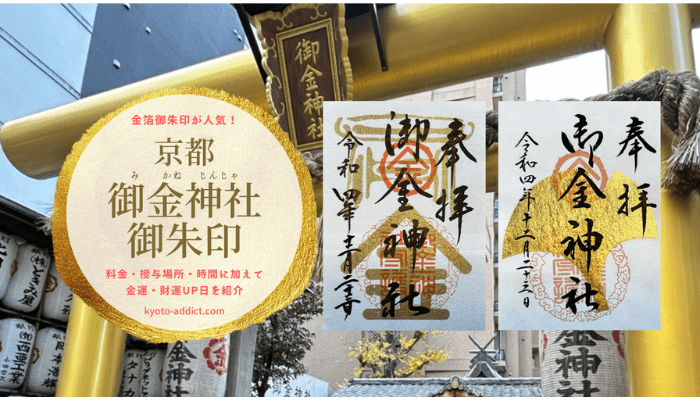
🔹 Cleansing Your Coins for Good Luck
At the shrine’s temizuya (purification fountain), you’ll find a small basket placed in the water. Visitors put their coins in the basket and wash them, believing that this ritual will cleanse the money and attract more wealth in return.
🔹 The Sacred Ginkgo Tree
Behind the main hall, a majestic ginkgo tree stands tall as the shrine’s sacred tree. It is believed that a dragon deity resides within it, adding to the shrine’s spiritual power.
🔹 Golden Goshuin (Temple Stamp)
Mikane Shrine’s goshuin (temple stamp) is shimmering gold, reflecting its connection to wealth. While it is not written directly into visitors’ goshuin books, you can receive a pre-prepared stamp with the date included.
Mikane Shrine
- Address: 614 Oshindoincho, Nakagyo-ku, Kyoto
- Google Maps: Click here
- Access:
- 5-minute walk from Karasuma Oike Station (Subway Karasuma Line)
- 5-minute walk from Nijo Castle Bus Stop
- Phone: 075-222-2062
- Opening Hours: 10:00 AM – 6:00 PM
- Admission: Free
- Official Website: Mikane Shrine
5. Shōan-in
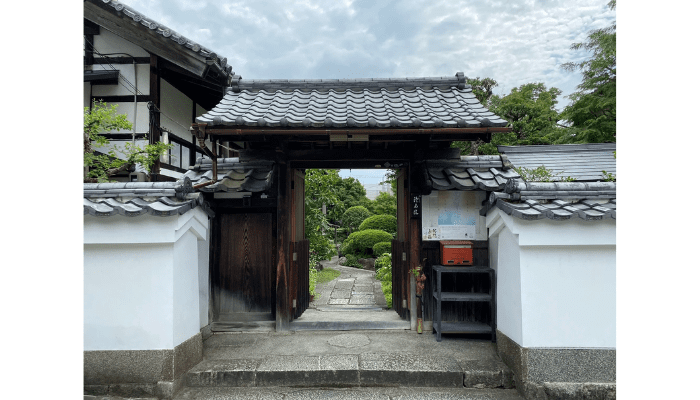
Located in the beautiful Sagano area of Kyoto, Shōan-in Temple (證安院) is a charming temple known for its adorable goshuin (temple stamps). While it was once famous for its majestic satsuki azalea tree, the tree has unfortunately withered. However, thanks to generous donations from temple supporters, the grounds have been transformed into a bright and serene garden, making it a peaceful place to visit.
Shōan-in has several types of goshuin, but the most popular one is the “Ojizō-sama and Mujōson” design. It features seven Ojizō-sama (guardian deities), each with a unique expression—some with their hands in prayer and others appearing to chant sutras. The gentle and heartwarming illustrations make this goshuin a favorite among visitors.
Another well-loved goshuin is “Hoshi ni Negai wo” (Wish Upon a Star), which features a dreamy star-themed design that adds to the temple’s tranquil atmosphere.

Since goshuin reservations are required, it’s best to check the temple’s official Twitter for the latest updates on availability and reception times. Note that inquiries are not accepted on Mondays and Wednesdays. If you’re unable to book in advance, pre-written (kakitoki) goshuin are also available, making it easier for travelers to get one during their visit.
The temple’s garden is particularly beautiful from mid-May to early June, making it an ideal time to visit. After exploring the temple grounds, take a moment to appreciate the peaceful scenery of the newly restored garden.
Shōan-in Temple
- Address: 22 Zenkojiyama-cho, Saga Nison-in Monzen, Ukyo-ku, Kyoto
- Google Maps: Click here
- Access:
- 6-minute walk from Gohodo Benten-mae Bus Stop (Kyoto Bus)
- Phone: 075-871-3923
- Opening Hours: 10:00 AM – 4:30 PM
- Admission: Free
- Important Note: Goshuin reservations must be made via the official Twitter or phone (except Mondays & Wednesdays)
Must-Visit Temples and Shrines for Discovering Hidden Gems
If you’ve already visited Kyoto’s famous tourist spots and are looking for something off the beaten path, why not explore hidden temples and shrines?
Kyoto is home to approximately 800 shrines and 1,700 temples, but only a fraction of them are widely known. In this guide, we’ll introduce you to some hidden gems—from lesser-known spots in the city to tranquil retreats in Kyoto’s countryside.
1. Sanzen-in Temple
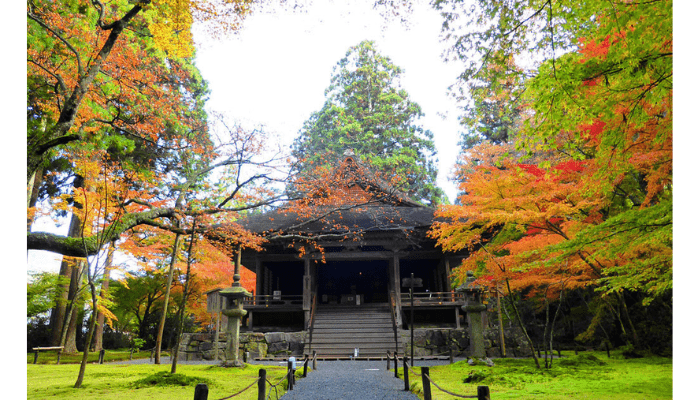
Located in the scenic village of Ohara, northeast of central Kyoto, Sanzen-in Temple is a peaceful retreat surrounded by nature. Ohara, with its traditional thatched-roof houses, offers a quiet and relaxing atmosphere, perfect for a slower-paced visit.
Ohara has long been a secluded place for nobles and monks seeking solitude away from the capital. Due to its remote location, it sees fewer tourists than central Kyoto, making it an ideal hidden spot to explore. Sanzen-in was originally founded by Saichō, the founder of the Tendai sect, at Enryaku-ji Temple on Mount Hiei. It was later relocated to its current location after the Meiji Restoration.
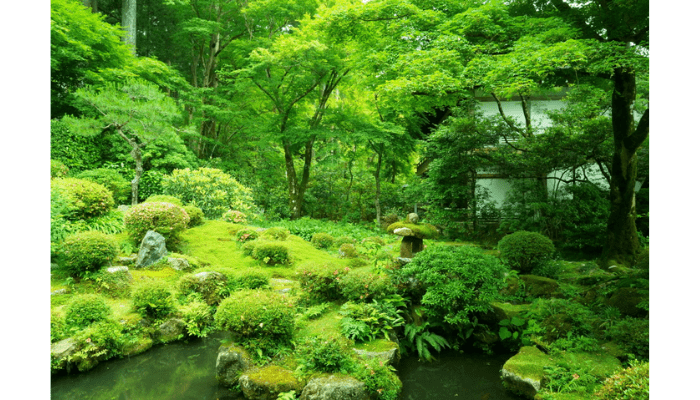
Sanzen-in features two stunning gardens, each with its own unique charm:
The first garden, Jūhekien, is best viewed from the temple’s guest hall. The carefully landscaped scenery creates a calming atmosphere, and visitors can enjoy matcha green tea and traditional sweets while admiring the view. According to legend, tea master Kanamori Sōwa was so moved by this garden that he helped refine its design, shaping it into the elegant space seen today.
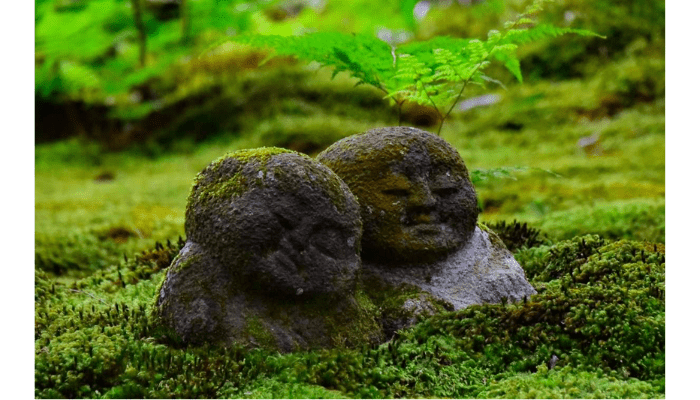
The second garden, Yūseien, is famous for its moss-covered landscape, which creates a mystical and serene setting. Within this garden stands the Ōjō Gokuraku-in Hall, a beautiful wooden structure surrounded by lush greenery.
One of the highlights of Yūseien is the adorable “Warabe Jizō” statues. These small stone Jizō figures, with their gentle smiling expressions, have been watching over the garden for years. Many visitors find their peaceful smiles incredibly heartwarming.
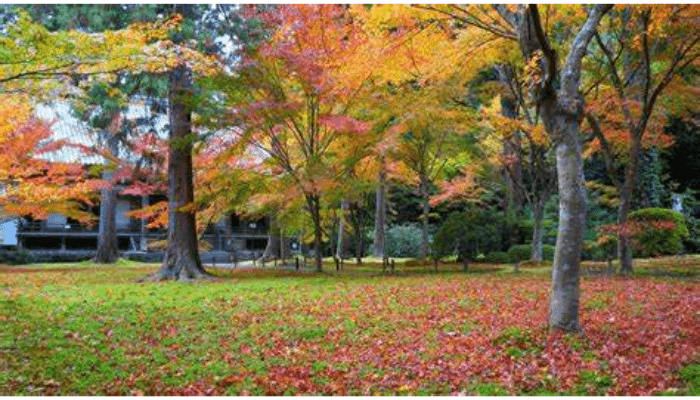
Sanzen-in is also a fantastic autumn foliage spot. From early to late November, the vivid red maple leaves create a breathtaking contrast against the lush green moss, making it a must-visit location during the fall season.
Sanzen-in Temple
- Address: 540 Raigōin-chō, Ohara, Sakyo-ku, Kyoto
- Google Maps: Click here
- Access:
- 10-minute walk from Ohara Bus Stop (Kyoto Bus No. 17)
- Phone: 075-744-2531
- Opening Hours:
- November: 8:30 AM – 5:00 PM
- December – February: 9:00 AM – 4:30 PM
- Admission Fee:
- Adults: ¥700
- Middle & High School Students: ¥400
- Elementary School Students: ¥150
- Official Website: Sanzen-in
2. Yōgen-in Temple
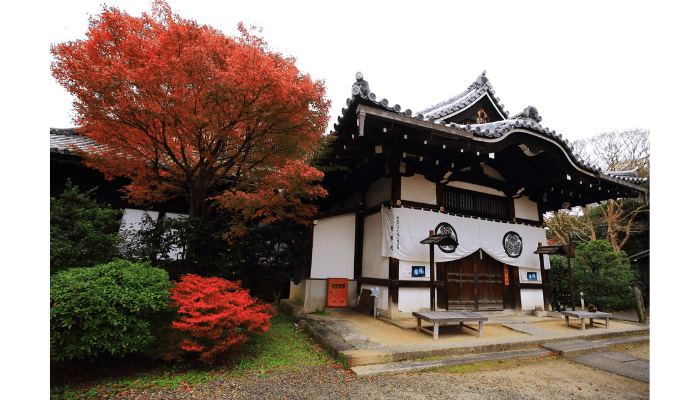
Yōgen-in Temple (養源院) is famous for its “Blood Ceiling” (血天井)—a chilling yet historically significant feature. The ceiling is made from floorboards stained with the blood of over 380 samurai who took their own lives after a fierce battle. While this may sound eerie, Yōgen-in is also home to stunning artwork and fascinating history, making it a must-visit hidden gem in Kyoto.
In 1600, during the Siege of Fushimi Castle, about 2,000 Tokugawa samurai, led by Torii Mototada, bravely defended the castle against an overwhelming 40,000-strong army led by Ishida Mitsunari, a general loyal to the Toyotomi clan. The battle lasted 10 days, and as their numbers dwindled, the remaining 380 warriors, including Torii, retreated to the castle’s inner hall and committed seppuku (ritual suicide) rather than surrender.
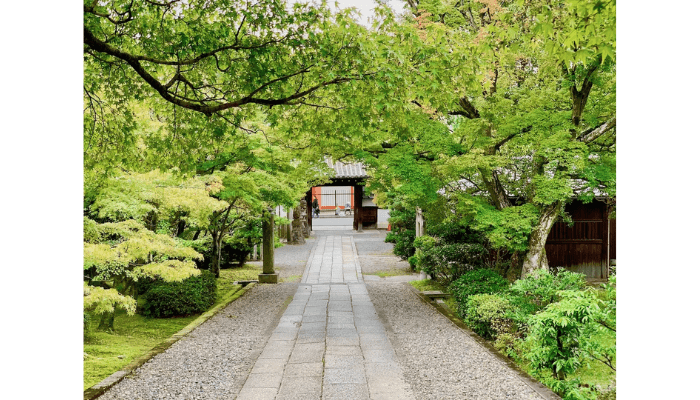
After the fall of Fushimi Castle, their bodies remained abandoned in the summer heat for nearly two months, causing their blood to seep deep into the wooden floorboards. When the castle was later dismantled, these bloodstained floorboards were repurposed as ceilings in several temples, including Yōgen-in, to honor and memorialize the fallen warriors.
When you look up at Yōgen-in’s ceiling, you can still see handprints, footprints, and stains left behind—a powerful reminder of the samurai’s unwavering loyalty and sacrifice.
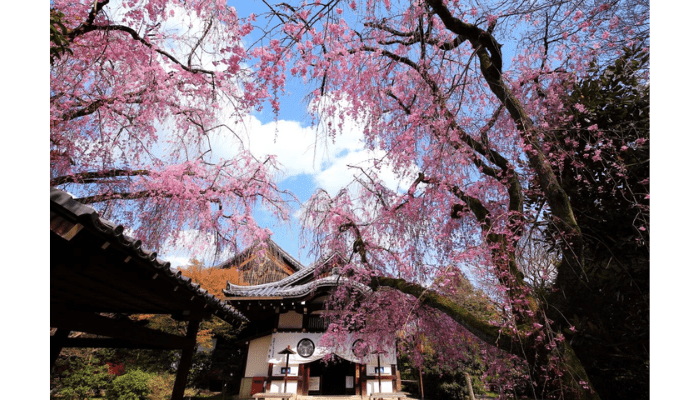
Beyond its haunting history, Yōgen-in Temple is also home to rare and breathtaking artworks. Inside the main hall, you’ll find fusuma (sliding door) paintings by the famous Edo-period artist Tawaraya Sōtatsu. His works include:
- “Pine Tree Paintings” (松図十二面) – A stunning set of 12 sliding door panels depicting majestic pine trees.
- “White Elephant, Chinese Lions, and Kirin Paintings” – Vivid, lifelike depictions of mythical and real animals on wooden doors.
These paintings are the only surviving fusuma artworks by Sōtatsu, making them an invaluable cultural treasure. The bold and dynamic brushwork gives the animals a sense of movement, as if they might leap off the panels at any moment.
Yōgen-in Temple
- Address: 656 Sanjūsangendō-Mawari-chō, Higashiyama-ku, Kyoto
- Google Maps: Click here
- Access:
- 3-minute walk from Higashiyama Nanajō Bus Stop (Kyoto City Bus, near Sanjūsangendō Temple)
- Phone: 075-561-3887
- Opening Hours: 9:00 AM – 4:00 PM
- Admission Fee: ¥500 (General)
3. Adashino Nenbutsu-ji Temple
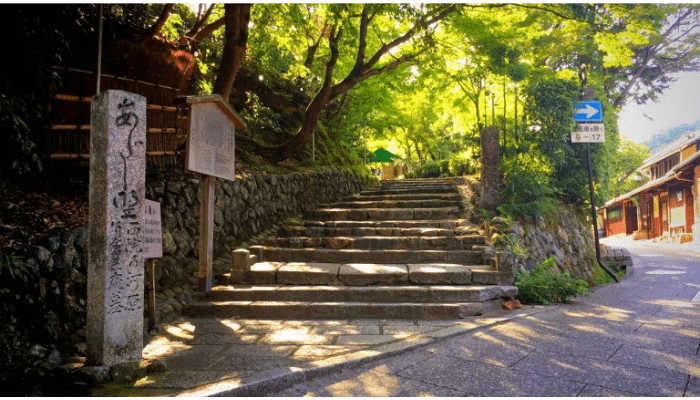
Adashino Nenbutsu-ji (化野念仏寺) is a historic temple in Saga-Toriimoto, a beautifully preserved district in Ukyo Ward, Kyoto. The area was once a burial site, and in the Heian period (794–1185), the Buddhist monk Kūkai (Kōbō Daishi) established a temple here, respectfully enshrining the remains of those who had been left exposed to the elements.
Today, Adashino Nenbutsu-ji is known for its thousands of stone Buddha statues, creating a deeply moving and spiritual atmosphere.
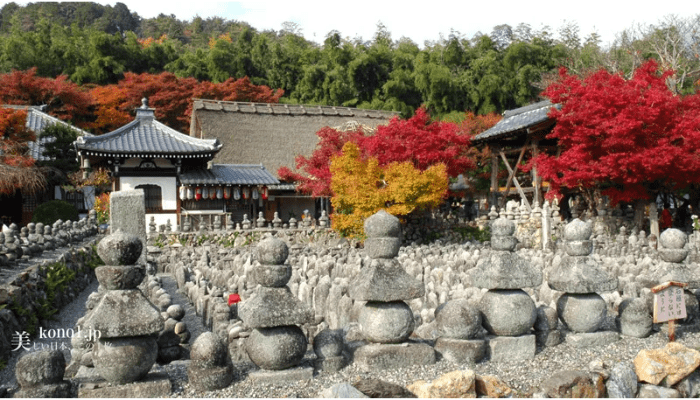
The highlight of the temple is Sai no Kawara (西院の河原), an area filled with around 8,000 stone statues and memorial tablets. Each of these tiny stone Buddhas represents the souls of the departed, making it a place of prayer and remembrance.
The sheer number of statues may leave you speechless on your first visit. The sight of thousands of stone figures standing together in silence is both solemn and awe-inspiring.
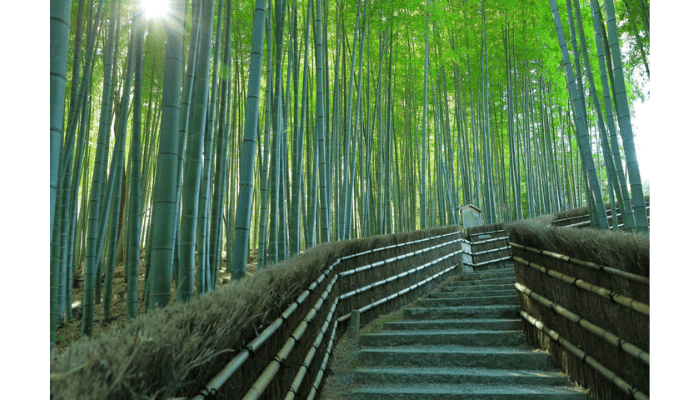
Another must-see spot within the temple grounds is the Bamboo Pathway, a serene and mystical walkway lined with towering bamboo stalks. Sunlight filters through the leaves, creating a dreamlike glow.
Since Saga-Arashiyama is famous for its bamboo forests, this hidden bamboo grove is a quieter, more intimate alternative to the popular Arashiyama Bamboo Grove.
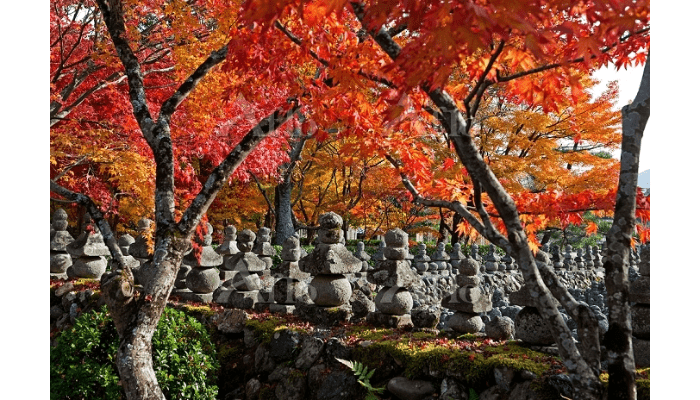
In autumn, Adashino Nenbutsu-ji is transformed as vibrant red maple leaves blanket the stone Buddhas. This stunning contrast of red leaves against the gray stone statues makes fall one of the best times to visit.
Take your time to enjoy the peaceful atmosphere, surrounded by autumn foliage and a quiet bamboo forest.
Adashino Nenbutsu-ji Temple
- Address: 17 Saga-Toriimoto Adashinochō, Ukyo-ku, Kyoto
- Google Maps: Click here
- Access:
- 5-minute walk from Torii-moto Bus Stop (Kyoto Bus)
- Phone: 075-861-2221
- Opening Hours: 9:00 AM – 4:30 PM (Last Entry)
- Admission Fee:
- Adults: ¥500
- Middle & High School Students: ¥400
- Children (Elementary & Below): Free
4. Yoshiminedera Temple
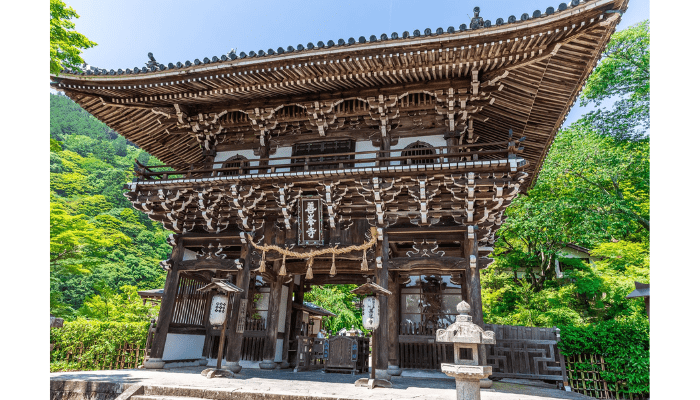
Yoshiminedera Temple (善峯寺) is a Tendai sect Buddhist temple located in Nishikyo Ward, Kyoto. It is one of the Three Great Temples of Nishiyama (西山三山), along with Yokoku-ji Temple (Yanagidani Kannon) and Komyo-ji Temple.
Perched on the slopes of Kyoto’s Nishiyama mountains, this temple offers breathtaking panoramic views of Kyoto City and Mount Hiei.
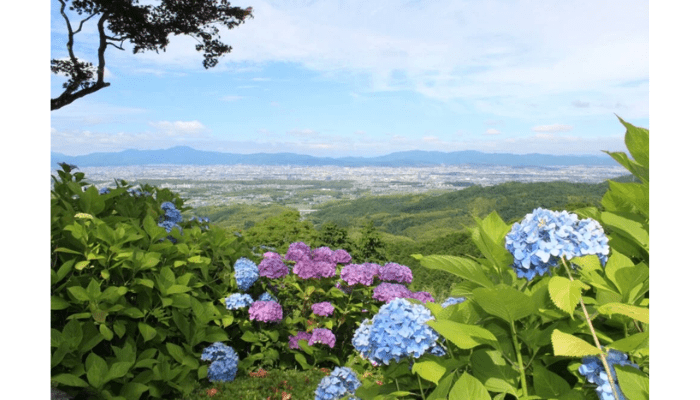
The area around Yoshiminedera has been a beloved retreat for aristocrats since the Heian period (794–1185). It was famous for hunting, cherry blossom viewing, and seasonal outings.
Since it is located a bit farther from Kyoto’s city center, fewer tourists visit, making it a hidden gem for those who appreciate tranquil, scenic spots.
Visitors can take a bus from the nearest station, enjoying the natural beauty of Ohara-no along the way. Many people come here for hiking and relaxation.
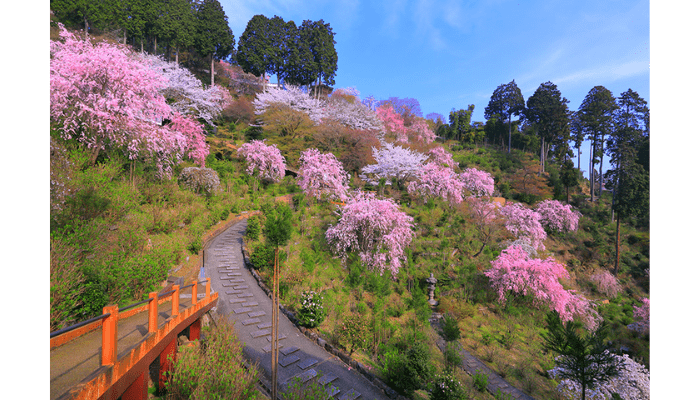
Yoshiminedera is especially famous for cherry blossoms. In 1999, it was featured in JR’s “Yes, Let’s Go to Kyoto” (そうだ、京都、行こう) campaign, which highlights Kyoto’s most beautiful seasonal spots.
The temple is home to a 300-year-old weeping cherry tree, said to have been planted by Keisho-in, the mother of the fifth Tokugawa shogun. During the cherry blossom season, the temple grounds are transformed into a pink wonderland, attracting visitors from all over Japan.
However, cherry blossoms are not the only attraction—
- Early summer: The temple’s hydrangeas bloom beautifully.
- Autumn: The grounds are covered in vibrant autumn leaves, making it a stunning fall foliage spot.
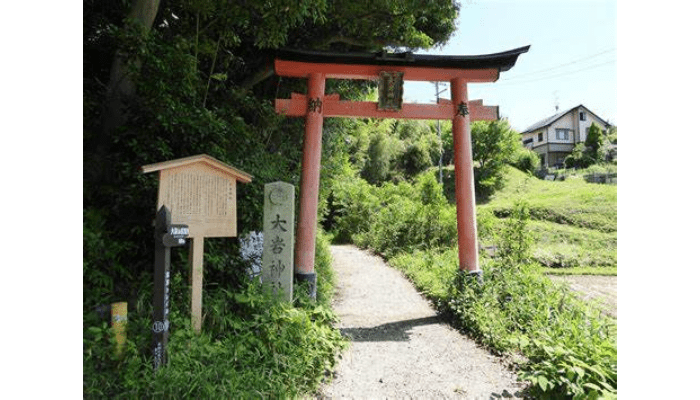
Another highlight is the 600-year-old Yuryu no Matsu (遊龍の松), a natural monument and the longest pine tree in Japan. Its dragon-like form stretches impressively across the temple grounds, leaving visitors in awe.
Since buses to Yoshiminedera are infrequent, it’s best to check the schedule and plan your return trip in advance.
Yoshiminedera Temple
- Address: 1372 Oharano Oshio-cho, Nishikyo-ku, Kyoto
- Google Maps: Click here
- Access:
- 20-minute walk from Yoshiminedera Bus Stop (Hankyu Bus)
- Phone: 075-331-0020
- Opening Hours: 8:00 AM – 5:00 PM
- Admission Fee:
- Adults: ¥500
- High School Students: ¥300
- Elementary & Middle School Students: ¥200
6. Oiwa Shrine
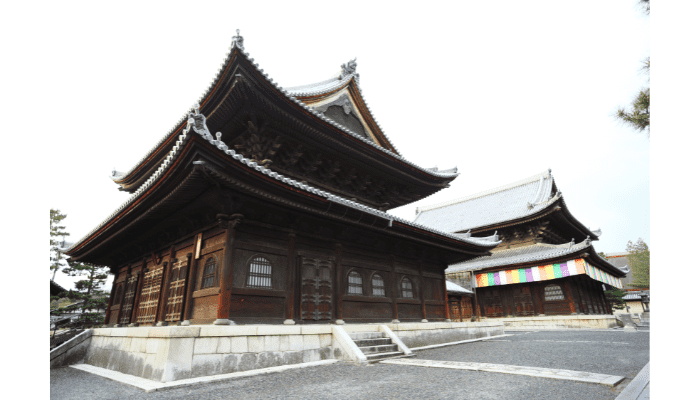
Oiwa Shrine (大岩神社), located in Fushimi Ward, Kyoto, is a hidden gem nestled deep in the mountains. Since reaching the shrine requires a short hike, few visitors make the journey, making it a quiet and mysterious place to explore.
Oiwa Shrine is unique because it worships two sacred rocks as deities—a male god (Oiwa Daijin) and a female god (Koiwa Daijin).
According to legend, these two deities took care of each other during illness and were eventually healed. Because of this, the shrine has long been worshiped as a place of healing, especially for tuberculosis. In the past, when tuberculosis was considered an incurable disease, many people came here to pray for recovery.
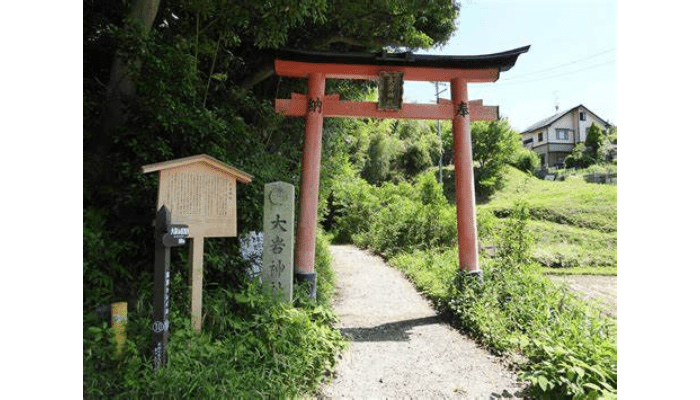
Walking up the lush, tree-lined mountain path, you will come across a strikingly unique torii gate. Unlike traditional Japanese torii gates, this one has an exotic, ancient temple-like appearance, almost like something from Southeast Asian ruins.
The gate is decorated with inscriptions of Oiwa Daijin and Koiwa Daijin, along with carvings of a goddess, a warrior, rabbits, and birds.
Interestingly, this one-of-a-kind torii was designed by Domoto Insho, a renowned Kyoto-born Nihonga (Japanese-style) painter, who donated it to the shrine.
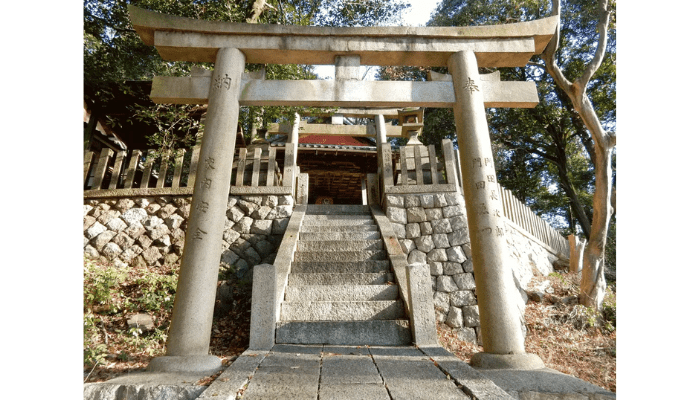
After passing through the mystical gate and continuing up the path, the scenery suddenly opens up. On clear days, you can enjoy breathtaking views of Osaka’s skyline in the distance.
Caution: Some areas of the shrine, including the shrine office, are restricted or unsafe to enter. Please be careful and pay attention to your surroundings while exploring.
Oiwa Shrine
- Address: 89-2 Fukakusa Mukōgahara-chō, Fushimi-ku, Kyoto
- Google Maps: Click here
- Access:
- 5-minute walk from the entrance of the shrine trail after getting off at Fukakusa Umadani-cho Bus Stop (Keihan Bus)
- Admission: Free
Kyoto is home to many historic shrines and temples, but most tourists only visit a few of the most famous ones.
By exploring lesser-known shrines and temples, you may discover a new side of Kyoto and experience its deeper charm.
Why not take the time to find your own favorite shrine or temple in Kyoto and enjoy a peaceful, healing moment?
▼ Related Articles for Kyoto Sightseeing
